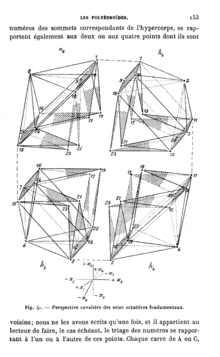- Maurice Princet
-
Maurice Princet (1875 – October 23, 1973)[1] was a French mathematician and actuary who played a role in the birth of cubism. He was an associate of Pablo Picasso, Guillaume Apollinaire, Max Jacob, Jean Metzinger, and Marcel Duchamp. He is known as "le mathématicien du cubisme" ("the mathematician of cubism").[2][3]
Princet is credited with introducing the work of Henri Poincaré and the concept of the "fourth dimension" to the cubists at the Bateau-Lavoir.[4] Princet brought to Picasso's attention a book by Esprit Jouffret, Traité élémentaire de géométrie à quatre dimensions (Elementary Treatise on the Geometry of Four Dimensions, 1903),[5] a popularization of Poincaré's Science and Hypothesis in which Jouffret described hypercubes and other complex polyhedra in four dimensions and projected them onto the two-dimensional page. Picasso's sketchbooks for Les Demoiselles d'Avignon illustrate Jouffret's influence on the artist's work.[6]
In 1907, Princet's wife left him for André Derain, and he drifted away from the circle of artists at the Bateau-Lavoir.[7] But Princet remained close to Metzinger and participated in meetings of the Section d'Or in Puteaux. He gave informal lectures to the group, many of whom were passionate about mathematical order.[8]
Princet's influence on the cubists was attested to by his contemporaries. Maurice Vlaminck wrote, "I witnessed the birth of cubism, its growth, its decline. Picasso was the obstetrician, Guillaume Apollinaire the midwife, Princet the godfather."[9]
In 1910, Metzinger said of him, "[Picasso] lays out a free, mobile perspective, from which that ingenious mathematician Maurice Princet has deduced a whole geometry".[10] Later, Metzinger wrote in his memoirs that:
Maurice Princet joined us often. Although quite young, thanks to his knowledge of mathematics he had an important job in an insurance company. But, beyond his profession, it was as an artist that he conceptualized mathematics, as an aesthetician that he invoked n-dimensional continuums. He loved to get the artists interested in the new views on space that had been opened up by Schlegel and some others. He succeeded at that.[11]
Louis Vauxcelles sarcastically dubbed Princet "the father of cubism":
M. Princet has studied at length non-Euclidean geometry and the theorems of Riemann, of which Gleizes and Metzinger speak rather carelessly. Now then, M. Princet one day met M. Max Jacob and confided him one or two of his discoveries relating to the fourth dimension. M. Jacob informed the ingenious M. Picasso of it, and M. Picasso saw there a possibility of new ornamental schemes. M. Picasso explained his intentions to M. Apollinaire, who hastened to write them up in formularies and codify them. The thing spread and propagated. Cubism, the child of M. Princet, was born.[12]
Duchamp told Pierre Cabanne, "We weren't mathematicians at all, but we really did believe in Princet".[13]
See also
Notes
- ^ Miller, Arthur I. (2001). Einstein, Picasso: Space, Time, and the Beauty That Causes Havoc. New York: Basic Books. pp. 171. ISBN 0465018602.
- ^ Miller. Einstein, Picasso. pp. 100. ISBN 0465018599. Miller cites:
- Salmon, André (1955). Souvenir sans fin, Première époque (1903–1908). Paris: Éditions Gallimard. pp. 187.
- Salmon, André (1956). Souvenir sans fin, Deuxième époque (1908–1920). Paris: Éditions Gallimard. pp. 24.
- Crespelle, Jean-Paul (1978). La Vie quotidienne à Montmartre au temps de Picasso, 1900-1910. Paris: Hachette. pp. 120. ISBN 2010053222.
- ^ Décimo, Marc (2007) (in French). Maurice Princet, Le Mathématicien du Cubisme. Paris: Éditions L'Echoppe. ISBN 2840681919.
- ^ Miller. Einstein, Picasso. pp. 101. ISBN 0465018599.
- ^ Jouffret, Esprit (1903) (in French). Traité élémentaire de géométrie à quatre dimensions et introduction à la géométrie à n dimensions. Paris: Gauthier-Villars. OCLC 1445172. http://historical.library.cornell.edu/cgi-bin/cul.math/docviewer?did=04810001. Retrieved 2008-02-06.
- ^ Miller. Einstein, Picasso. pp. 106–117.
- ^ Robbin, Tony (2006). Shadows of Reality, The Fourth Dimension in Relativity, Cubism, and Modern Thought. New Haven: Yale University Press. pp. 34. ISBN 0300110391.
- ^ Everdell, William R. (1997). The First Moderns: Profiles in the Origins of Twentieth-Century Thought. Chicago: University of Chicago Press. pp. 312. ISBN 0226224805.
- ^ Vlaminck, Maurice (June 6, 1942). "Opinions libres... sur la peinture". Comédia: 1, 6. "J'ai assisté à la naissance du cubisme, à sa croissance, à son déclin. Picasso en fut l'accoucheur, Guillaume Apollinaire la sage-femme, Princet le parrain." in Seckel, Hélène (1994). "Anthology of Early Commentary on Les Demoiselles d'Avignon". In William Rubin, Hélène Seckel, and Judith Cousins. Les Demoiselles d'Avignon. New York: Museum of Modern Art. pp. 264. ISBN 0870701622.
- ^ Metzinger, Jean (October-November 1910). "Note sur la peinture". Pan: 60. in Miller. Einstein, Picasso. pp. 167.
- ^ Metzinger, Jean (1972). Le cubisme était né. Paris: Éditions Présence. pp. 43–44. in Ferry, Luc (1993). Homo Aestheticus: The Invention of Taste in the Democratic Age. Robert De Loaiza, trans.. Chicago: University of Chicago Press. pp. 215. ISBN 0226244598.
- ^ Vauxcelles, Louis (December 29, 1918). "Le Carnet des ateliers: La Père du cubisme". Le Carnet de la semaine: 11. in Henderson, Linda Dalrymple (1983). The Fourth Dimension and Non-Euclidean Geometry in Modern Art. Princeton: Princeton University Press. p. 72. ISBN 0691101426.
- ^ Cabanne, Pierre (1971). Dialogues with Marcel Duchamp. London: Thames and Hudson. pp. 39. in Crunden, Robert Morse (1993). American Salons: Encounters with European Modernism, 1885-1917. New York: Oxford University Press. pp. 431. ISBN 0195065697.
Further reading
- Décimo, Marc (2007) (in French). Maurice Princet, Le Mathématicien du Cubisme. Paris: Éditions L'Echoppe. ISBN 2840681919.
- Henderson, Linda Dalrymple (1983). The Fourth Dimension and Non-Euclidean Geometry in Modern Art. Princeton: Princeton University Press. ISBN 0691101426.
- Miller, Arthur I. (2001). Einstein, Picasso: Space, Time, and the Beauty That Causes Havoc. New York: Basic Books. ISBN 0465018602.
Categories:- Actuaries
- Cubism
- French art
- French mathematicians
- 1875 births
- 1973 deaths
Wikimedia Foundation. 2010.

